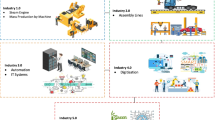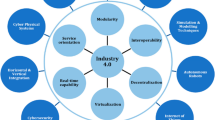Abstract
The ever-increasing distributed, networked and crowd-sourced cloud environment imposes the need of a service-oriented product data model for explicit representation of service requests in global manufacturing-service networks. The work in this paper aims to develop such a description framework for products based on semantic web technologies to facilitate the make-to-individual production strategy in a cloud manufacturing environment. A brief discussion on the requirements of a product data model in cloud manufacturing and research on product data modelling is given in the first part. A systematic ontology development methodology is then proposed and elaborated. The ontology called ManuService has been developed, consisting of all necessary concepts for description of products in a service-oriented business environment. These concepts include product specifications, quality constraints, manufacturing processes, organisation information, cost expectations, logistics requirements, and etcetera. ManuService ontology provides a module-based, reconfigurable, privacy-enhanced and standardised approach to modelling customised manufacturing service requests. An industrial case is presented to demonstrate possible applications using ManuService ontology. Comprehensive discussions are given thereafter, including a pilot application of a software package for semantic-based product design and a semantic web-based module for intelligent knowledge-based decision-making based on ManuService. ManuService forms the basis for collaborative service-oriented business interactions, intelligent and secure service provision in cloud manufacturing environment.















Similar content being viewed by others
References
Berners-Lee, T., Hendler, J., & Lassila, O. (2001). The semantic web. Scientific American, 284(5), 34–43.
Bock, J., Haase, P., Ji, Q., & Volz, R. (2008). Benchmarking OWL reasoners. In CEUR workshop proceedings (Vol. 350).
Chungoora, N., Cutting-Decelle, A. F., Young, R. I. M., Gunendran, G., Usman, Z., Harding, J. A., et al. (2013). Towards the ontology-based consolidation of production-centric standards. International Journal of Production Research, 51(2), 327–345.
Dong, M., Yang, D., & Su, L. (2011). Ontology-based service product configuration system modeling and development. Expert Systems with Applications, 38(9), 11770–11786.
Dun & Bradstreet Inc. (2013). The D&B D-U-N-S number—The universal standard for business identification. Retrieved from http://www.dnb.com/content/dam/english/dnb-datainsight/duns_number_overview_2011.pdf.
Gennari, J. H., Musen, M. A., Fergerson, R. W., Grosso, W. E., Crubezy, M., Eriksson, H., et al. (2003). The evolution of Protégé: An environment for knowledge-based systems development. International Journal of Human Computer Studies, 58(1), 89–123. doi:10.1016/S1071-5819(02)00127-1.
Gómez-Pérez, A., Fernandez-Lopez, M., & Corcho, O. (2006). Ontological engineering: With examples from the areas of Knowledge Management, e-Commerce and the Semantic Web. New York: Springer.
Grau, B. C., Horrocks, I., Motik, B., Parsia, B., Patel-Schneider, P., & Sattler, U. (2008). OWL 2: The next step for OWL. Web Semantics, 6(4), 309–322.
GS1. (n.d.). Global location numbers (GLN): A key enabler for improving efficiency and visibility of the supply and demand chains. Retrieved from http://www.gs1.org/docs/idkeys/GS1_Global_Location_Numbers.pdf.
Hepp, M. (2008). GoodRelations: An ontology for describing products and services offers on the web. Lecture Notes in Computer Science (including subseries Lecture Notes in Artificial Intelligence and Lecture Notes in Bioinformatics), 5268 LNAI (pp. 329–346). doi:10.1007/978-3-540-87696-0-29.
ISO. (1994). ISO 10303–1: Industrial automation systems and integration-product data representation and exchange-part 1: Overview and fundamental principles. Geneva: ISO.
ISO. (2003). ISO 14649-1: Industrial automation systems and integration—Physical device control—Data model for computerized numerical controllers—Part 1: Overview and fundamental principles. Geneva: ISO.
ISO. (2005). ISO 10303-240: Industrial automation systems and integration-Product data representation and exchange-Part 240: Application protocol: Process plans for machined products. Geneva: ISO.
ISO. (2014). ISO 10303-41. Industrial automation systems and integration-product data representation and exchange—Part 41: Integrated generic resource: Fundamentals of product description and support. Geneva: ISO.
Kadner, K., Oberle, D., Schaeffler, M., Horch, A., Kintz, M., Barton, L., et al. (2011). Unified service description language XG final report. W3C Incubator Group Report (Vol. 27).
Kim, K.-Y., Manley, D. G., & Yang, H. (2006). Ontology-based assembly design and information sharing for collaborative product development. Comput. Aided Des., 38(12), 1233–1250. doi:10.1016/j.cad.2006.08.004.
Lassila, O., & Swick, R. R. (1999). Resource description framework (RDF) model and syntax specification. W3C Recommendation, 1999.
Lee, J., Chae, H., Kim, C. H., & Kim, K. (2009). Design of product ontology architecture for collaborative enterprises. Expert Systems with Applications, 36(2 PART 1), 2300–2309. doi:10.1016/j.eswa.2007.12.042.
Lu, Y., & Xu, X. (2015). Protecting intellectual property in a cloud manufacturing environment: Requirements and strategies. In S. Umeda, M. Nakano, H. Mizuyama, H. Hibino, D. Kiritsis, & G. von Cieminski (Eds.), Advances in Production Management Systems: Innovative Production Management Towards Sustainable Growth (pp. 404–411). New York: Springer.
Lu, Y., Shao, J., Singh, C., Xu, X., & Ye, X. (2014a). Ontology for manufacturing resources in a cloud environment. International Journal of Manufacturing Research, 9(4), 448–469.
Lu, Y., Xu, X., & Xu, J. (2014b). Development of a hybrid manufacturing cloud. Journal of Manufacturing Systems, 33(4), 551–566.
Makris, S., Xanthakis, V., Mourtzis, D., & Chryssolouris, G. (2008). On the information modeling for the electronic operation of supply chains: A maritime case study. Robotics and Computer-Integrated Manufacturing, 24(1), 140–149. doi:10.1016/j.rcim.2006.08.004.
Manenti, P., Paolone, P., & Veronesi, L. (2013). Business strategy: The journey toward the people-intensive factory of the future (Doc #MIOT02V). IDC Manufacturing Insights: Operations Technology Strategies. Internatioanl Data Corporation.
McGuinness, D. L., & Van Harmelen, F. (2004). OWL web ontology language overview. W3C Recommendation, 10(10), 2004.
Panetto, H., Dassisti, M., & Tursi, A. (2012). ONTO-PDM: Product-driven ONTOlogy for Product Data Management interoperability within manufacturing process environment. Advanced Engineering Informatics, 26(2), 334–348. doi:10.1016/j.aei.2011.12.002.
Pinto, H. S., Staab, S., & Tempich, C. (2004). DILIGENT: Towards a fine-grained methodology for distributed, loosely-controlled and evolvInG. In Proceedings of the 16th European Conference on Artificial Intelligence (ECAI 2004) (Vol. 110, p. 393).
Staab, S., Studer, R., Schnurr, H. P., & Sure, Y. (2001). Knowledge processes and ontologies. IEEE Intelligent Systems and Their Applications, 16(1), 26–34.
Suárez-Figueroa, M. C., Gómez-Pérez, A., Muñoz, O., & Vigo, M. (2010). gOntt, A tool for scheduling and executing ontology development projects. SEKE 2010—Proceedings of the 22nd International Conference on Software Engineering and Knowledge Engineering (pp. 614–619).
United Nations. (2008). International Standard Industrial Classification of All Economic Activities (ISIC), Rev. 4. United Nations Statistical Papers, (4).
Uschold, M., & Gruninger, M. (1996). Ontologies: Principles, methods and applications. Knowledge Engineering Review, 11(2), 93–136.
Valilai, O. F., & Houshmand, M. (2010). INFELT STEP: An integrated and interoperable platform for collaborative CAD/CAPP/CAM/CNC machining systems based on STEP standard. International Journal of Computer Integrated Manufacturing, 23(12), 1095–1117.
Xu, X. (2012). From cloud computing to cloud manufacturing. Robotics and Computer-Integrated Manufacturing, 28(1), 75–86.
Yang, J., Han, S., Grau, M., & Mun, D. (2009). OpenPDM-based product data exchange among heterogeneous PDM systems in a distributed environment. International Journal of Advanced Manufacturing Technology, 40(9–10), 1033–1043. doi:10.1007/s00170-008-1399-3.
Zhang, Y., Luo, X., Li, J., & Buis, J. J. (2013). A semantic representation model for design rationale of products. Advanced Engineering Informatics, 27(1), 13–26. doi:10.1016/j.aei.2012.10.005.
Zhao, W., & Liu, J. K. (2008). OWL/SWRL representation methodology for EXPRESS-driven product information model. Part I. Implementation methodology. Computers in Industry, 59(6), 580–589.
Author information
Authors and Affiliations
Corresponding author
Rights and permissions
About this article
Cite this article
Lu, Y., Wang, H. & Xu, X. ManuService ontology: a product data model for service-oriented business interactions in a cloud manufacturing environment. J Intell Manuf 30, 317–334 (2019). https://doi.org/10.1007/s10845-016-1250-x
Received:
Accepted:
Published:
Issue Date:
DOI: https://doi.org/10.1007/s10845-016-1250-x




